The ancient land of Thang Long is renowned for its temples that bear cultural and historical significance, creating a unique character for this thousand-year-old civilization. However, due to war, many monuments and temples were destroyed or are no longer intact. Bao An Temple and Bao Thien Temple were two of the largest and most magnificent temples in the capital during the 19th century.
Regrettably, both temples were destroyed during the war. Nevertheless, for the residents of the capital, these two temples remain forever etched in their hearts.
Bao An Temple: A Prime Feng Shui Location
Bao An Temple was the largest temple in Northern Vietnam during the 19th century, with a unique architecture that exemplifies the philosophy of “Confucianism in practice, Buddhism in belief” during the Nguyen Dynasty. The temple was constructed during the reign of Emperor Thieu Tri (1841 – 1847) under the leadership of Governor Nguyen Dang Giai, who oversaw the fundraising for its construction. The temple was built on a vast area of nearly 100 acres along the eastern shore of Hoan Kiem Lake.
This area was formerly known as Ngũ Long Pavilion of Lord Trinh Doanh (1740-1767), located in the village of Cuu Lau, Tho Xuong District, adjacent to Hoan Kiem Lake. The front of Bao An Temple faces the Red River, while its back rests against Hoan Kiem Lake. Surrounding the temple is a moat filled with lotus plants, leading many to refer to Bao An Temple as Liên Trì Temple (Lotus Pond Temple).
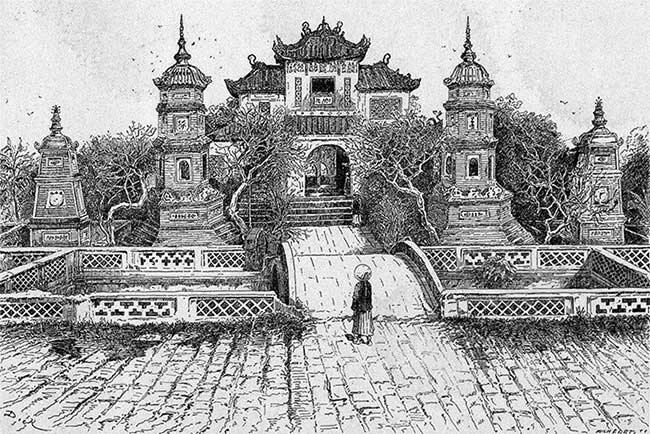
Painting of Bao An Temple recreated from a photo by Dr. Hocquard, 1888. (Source: Xa Loi Temple)
It can be said that Bao An Temple was chosen to be built in a location that feng shui experts would describe as prime, as it embodies the essential elements of wind (phong) and water (thuỷ). Such a location is typically described in feng shui as “Left Blue Dragon, Right White Tiger, Vermilion Bird, and Black Tortoise.”
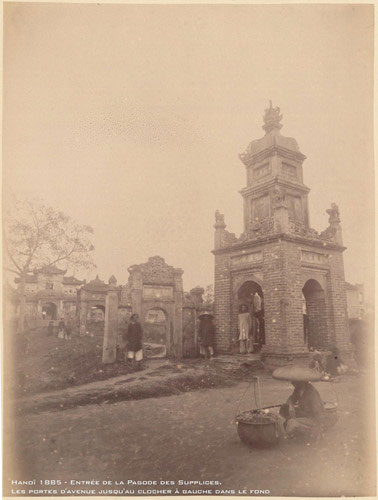
Entrance to Bao An Temple and Hoà Phong Tower. Photo taken in 1885. (Source: Buddhist Information Portal)
Bao An Temple was constructed on a grand scale, consisting of 180 compartments and 36 rooftops, surrounded by a hexagonal wall. In addition to its intricate architecture, the temple also housed a large number of statues. Notably, the statues in the temple were painted in red and gilded; many were even adorned with meticulously crafted mother-of-pearl inlays.
According to surviving documentation, the entrance to Bao An Temple began from the road along the eastern lake, leading to the Hoà Phong Tower and then to the temple gate. Crossing over a brick-paved bridge leads to the two-story Tam Quan gate. On either side of Tam Quan stood four symmetrical three-story stupa towers, artistically crafted and skillfully designed. Further inside is the Dai Hung Hall, which housed numerous beautifully carved wooden statues of Buddhas and Bodhisattvas, all painted and gilded. Next are the Holy Hall, monk quarters, and lecture hall… Surrounding these are cloisters depicting “The Ten Courts of Hell,” illustrating the tortures in the ten levels of hell for sinners, which were highly regarded for their vividness. Because of this layout, the French referred to Bao An Temple as Pagoda des Supplices (The Torture Pagoda).
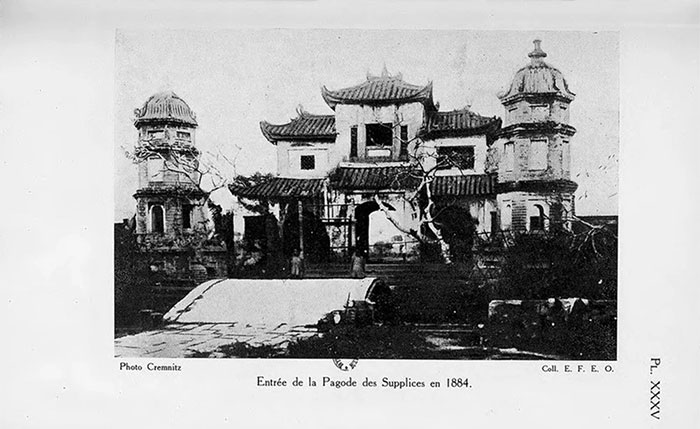
Gate of Bao An Temple in 1885. (Source: Collected Documentation).
Dr. Hocquard, who took many photographs of Bao An Temple, detailed it as follows: “From afar, the eyes of visitors are drawn to the bell towers, columns, and small pagodas. Upon entering the main hall, the vast scale, amidst the splendid golden columns, showcases over two hundred statues of deities lined up. In the center is the altar of Buddha Shakyamuni, 1.5 meters tall, gilded from head to toe, seated on a lotus throne, with half-closed eyes looking down at the palms resting on his knees. Two great disciples stand by his side…”
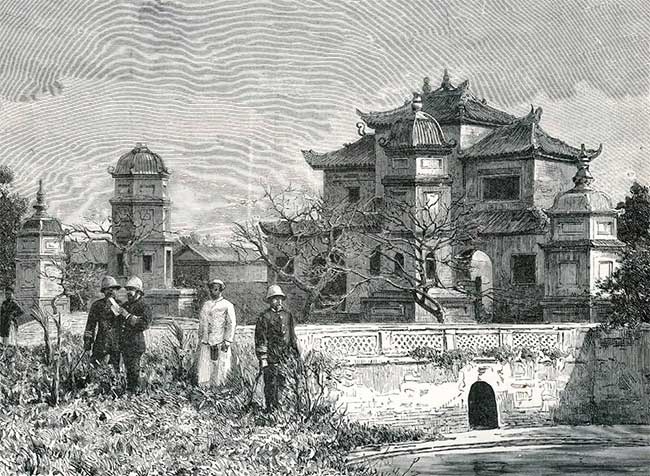
View from the inner gate of Bao An Temple, 1885. (Source: Collected Documentation)
Bao Thien Temple: One of the “Four Great Treasures of An Nam”
Bao Thien Temple, fully named “Sùng Khánh Báo Thiên Tự,” is one of the largest, most majestic ancient temples in Vietnamese history. According to historical descriptions, Bao Thien Temple was built in the village of Tien Thi, Tho Xuong District (formerly known as Bao Thien Ward), near Lake Luc Thuy (present-day Hoan Kiem Lake), outside the walls of Thang Long.
Unlike Bao An Temple, Bao Thien Temple was constructed much earlier, around 1056 during the reign of Emperor Ly Thanh Tong (1054 – 1071). This was a time when Buddhism was flourishing in Vietnam. During this period, the Ly Dynasty regarded Buddhism as the state religion, and the architecture of the temple is considered to have reached the pinnacle of Ly artistic achievement.
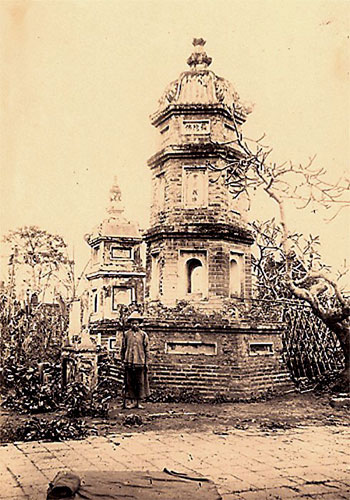
Illustration of Bao Thien Tower – One of the Four Great Treasures of An Nam.
Historical descriptions also mention the Bao Thien Tower, one of the Four Great Treasures of An Nam of ancient Vietnam. In the fourth year of Long Thuy Thai Binh (1057), Emperor Ly Thanh Tong commissioned the casting of a large bell weighing twelve thousand taels (approximately 7,260 kg) to be placed in the temple.
According to documentation, Bao Thien Tower was 12 stories high (approximately 80 meters), officially named Đại Thắng Tư Thiên Bảo Tháp. Inside, it was decorated with many exquisitely carved stone statues, and the tower’s spire was beautifully crafted from bronze.
Unfortunately, in 1426 (some documents state 1427), the Ming army, besieged in Dong Quan, melted down many valuable bronze treasures, including the Great Bell and the spire of Bao Thien Tower, to create weapons to fight against the Lam Son insurgents.
In 1443, King Le Thai Tong significantly renovated the temple; the destroyed Bao Thien Tower was elevated with a platform where the current St. Joseph’s Cathedral stands. From the reign of Le Thai Tong to the 19th century, Bao Thien Temple was the site of Buddhist ceremonies praying for good weather and national peace.
The book Đại Nam nhất thống chí mentions that in 1849, Governor Ton That Bat repaired the temple. According to the book Non Nuoc Ha Noi by author Quang Van, near the end of the 19th century, Bao Thien Temple was devastated by a major fire that destroyed many structures, forcing the monks to relocate, leaving Bao Thien Temple abandoned.
Almost No Remnants Left
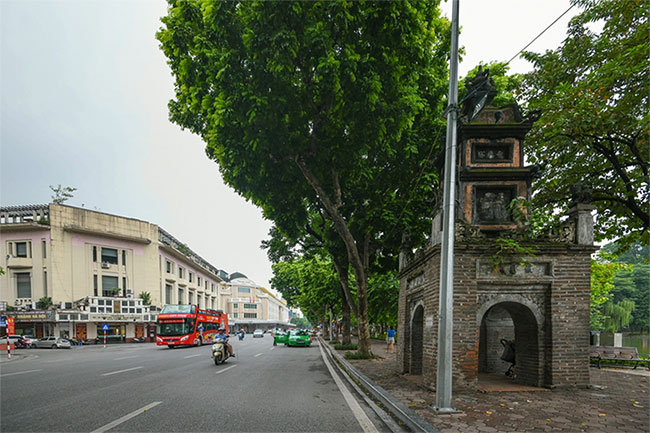
Hoà Phong Tower today.
Once magnificent and grand in the ancient capital of Thang Long, these two temples have not survived to this day. Bao An Temple and Bao Thien Temple are believed to have been destroyed by the French colonists, and today, almost no traces remain.
Bao An Temple was included in a plan to transform Hanoi into a “small France of the Far East.” The temple was completely destroyed, and the most beautiful Buddha statues were taken back to France by Consul Bonnal. Currently, only the Hoà Phong Tower remains by Hoan Kiem Lake, the only relic proving the existence of Bao An Temple.
Bao Thien Temple suffered a similar fate. In 1883, at the request of Consul Bonnal, the governor of Bac Ky, Ton That Do, handed over the temple land to Bishop Puginier to demolish the remaining parts to build St. Joseph’s Cathedral. Today, the remnants of Bao Thien Temple consist only of an ancient stone well, intricately carved with lotus flowers. In 2005, the ancient well was excavated and relocated to the area of the Grotto of Our Lady within the cathedral grounds.
|
Footnotes: (1) Ngũ Long Pavilion: A pavilion located outside the Tuyên Vũ gate of the Trinh lord’s palace (now Hanoi Post Office), serving as a retreat for the Trinh lord. (2) Four Great Treasures of An Nam: Refers to the four wonders, four national treasures, and four bronze artworks of Ly and Tran culture, including: the Buddha statue of Quynh Lam Pagoda (Quynh Lam Pagoda, Dong Trieu, Quang Ninh), Bao Thien Tower in Thang Long (Hanoi), Quy Dien Bell (turtle-shaped bell) at Dien Huu Pagoda (One Pillar Pagoda), Hanoi, and Phu Minh Cauldron at Phu Minh Pagoda, Thien Truong (Nam Dinh). (3) Đại Nam nhất thống chí: A geographical and historical book of Vietnam, written in Classical Chinese by the National History Institute during the reign of Emperor Tu Duc. It can be considered the largest and most important geographical book of Vietnam during the feudal era. (4) Great Bell: Also known as a bell, it is a sacred instrument that is essential in every temple.
Leave a Reply |




















































